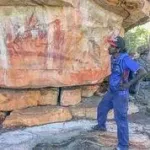Modern analysis of rock art
Machine learning opens new doors in archaeology
2021-03-31
(Press-News.org) Rock art of human figures created over thousands of years in Australia's Arnhem Land has been put through a transformative machine learning study to analyse style changes over the years.
The study has tested different styles labelled 'Northern Running figures', 'Dynamic figures', 'Post Dynamic figures' and 'Simple figures with Boomerangs' to understand how these styles relate to one another.
Working with the Mimal and Marrku Traditional Owners of the Wilton River area in Australia's Top End, South Australian researchers led by Flinders University archaeologist Dr Daryl Wesley have taken a closer look at the art of this region.
Flinders researcher Jarrad Kowlessar and the team used machine learning to analyse images of rock art collected during surveys in Marrku country in 2018 and 2019.
Co-authors include Dudley Lawrence and Abraham Weson and others from the Mimal Land Management Aboriginal Corporation, Alfred Nayinggul from the Njanjma Aboriginal Corporation, Dr Ian Moffat from Flinders and University of Adelaide researcher James Keal.
The reconstructed rock art chronology, just published in Australian Archaeology, uses existing data sets of more than 14 million different photos of a wide range of things from animals such as dogs, cats, lizards and insects to objects like chairs, tables and cups.
"In total the computer saw more than 1000 different types of objects and learned to tell the difference between them just by looking at photos of them," Dr Wesley explains.
"The important skill this computer developed was a mathematical model that has the ability to tell how similar two different images are to one another."
Then the mathematical modelling was applied to the images collected in northern Australia.
"This approach allows us to use the computer program to show how unique the rock art is in the Wilton River and how it relates to the rock art in other parts of Arnhem Land," Dr Wesley says.
"We can use this to help to show how rock art styles are shared by Traditional Owners in Arnhem Land and which are unique to each group through the past."
Machine learning allows a computer to 'learn' different things about information that may take a human many years to look through and learn from, explains a Flinders University PhD candidate in archaeology Jarrad Kowlessar, who has pioneered the machine learning approach for rock art analysis.
"One amazing outcome is that the machine learning approach ordered the styles in the same chronology that archaeologists have ordered them in by inspecting which appear on top of which. This shows that similarity and time are closely linked in the Arnhem Land rock art and that human figures drawn closer in time were more similar to one another then those drawn a long time apart," he says.
"For example the machine learning algorithm has plotted Northern Running figures and Dynamic figures very close to one another on the graph it produces. This shows that these styles which we know are closer to each other in age are also closer to each other in appearance, which might be a very hard thing to notice without an approach like this".
The article points out the new methodology removed a large degree of individual human interpretation and possible bias by using a machine learning approach called 'transfer learning'.
This allowed the computer to understand how each style related to one another directly - independently of the researchers involved.
Researchers are enthusiastic about this methodology breaking new ground for a large amount of archaeological research to understand all sorts of different human material culture in a different way.
INFORMATION:
The paper, 'Reconstructing rock art chronology with transfer learning: A case study from Arnhem Land, Australia' (2021) by Jarrad Kowlessar, James Keal, Daryl Wesley, Ian Moffat, Dudley Lawrence, Abraham Weson, Alfred Nayinggul and the Mimal Land Management Aboriginal Corporation has been published in Australian Archaeology DOI: 10.1080/03122417.2021.1895481
[Attachments] See images for this press release:

ELSE PRESS RELEASES FROM THIS DATE:
2021-03-31
Highlights
A newly developed tool assesses patients' home dialysis experience.
The 26-item Home Dialysis Care Experience instrument will be a resource for future research use, clinical care, and quality improvement initiatives among home dialysis facilities and organizations.
Washington, DC (March 30, 2021) -- Researchers have developed a new tool to assess patients' opinions and experience concerning home dialysis care. The tool is described in an upcoming issue of CJASN.
Home dialysis, which includes both peritoneal dialysis and home hemodialysis, allows patients to receive their dialysis treatments at home, gives patients independence and flexibility ...
2021-03-30
BOSTON - COVID-19 can have damaging effects on multiple organs in the body, including the brain. A new study led by investigators at Massachusetts General Hospital (MGH) and Beth Israel Deaconess Medical Center (BIDMC) indicates that some hospitalized patients with COVID-19 experience non-convulsive seizures, which may put them at a higher risk of dying. The findings are published in the Annals of Neurology.
"Seizures are a very common complication of severe critical illness. Most of these seizures are not obvious: Unlike seizures that make a person fall down and shake, or convulse, ...
2021-03-30
HOUSTON - (March 30, 2021) - Whether parents prefer a conformance-oriented or independence-oriented supplemental education program for their children depends on political ideology, according to a study of more than 8,500 American parents by a research team from Rice University and the University of Texas at San Antonio.
"Conservative parents have a higher need for structure, which drives their preference for conformance-oriented programs," said study co-author Vikas Mittal, a professor of marketing at Rice's Jones Graduate School of Business. "Many parents ...
2021-03-30
Boulder, Colo., USA: Anthropogenic climate change is one of the foremost scientific and societal challenges. In part, our response to this global challenge requires an enhanced understanding of how the Earth's surface responds to episodes of climatic heating and cooling. As historical records extend back only a few hundred years, we must look back into the ancient rock record to see how the surface of the Earth has responded to shifts between icehouse (presence of ice at the Earth's poles) and greenhouse (no substantial ice at Earth's poles) climates in the past.
In ...
2021-03-30
NEW YORK, NY (March 30, 2021)--Early in the pandemic, neurologists expressed concern that COVID-19 patients with dementia may be at higher risk for complications and mortality.
But those fears have not been realized, according to a new study of patients who were hospitalized with COVID-19 during the first wave of the pandemic in New York City. The study, led by James Noble, MD, MS, associate professor of neurology at Columbia University Vagelos College of Physicians and Surgeons and the Taub Institute for Research on Alzheimer's Disease and the Aging Brain, and Amro Harb, a Vagelos medical student, was published this month in ...
2021-03-30
A year ago scientists everywhere were scrambling to get their minds around the SARS-CoV-2, a novel coronavirus that caused the pandemic from which we are only now beginning to emerge. The world clung to every new development, every bit of science that could provide clues to managing life in the presence of this mysterious killer.
Many science-backed COVID-19 management concepts remain unchanged to this day: handwashing with soap and warm water disrupts the virus' lipid membrane. Social distancing can attenuate the virus's spread, ideally keeping it out of a host until it degrades. Other notions, such as droplet contact being the primary mode of transmission, were modified when emerging evidence showed that under ...
2021-03-30
Not all species may travel the same path to existence, at least according to new findings from the University of Colorado Boulder and collaborators.
This new research, out now in Science, looked at a newly discovered, endangered songbird located only in South America--the Iberá Seedeater--and found that this bird followed a very rare evolutionary path to come into existence at a much faster pace than the grand majority of species.
By comparing this bird to a closely related neighbor (the Tawny-Bellied Seedeater) in the same group (the southern capuchino seedeaters), the researchers determined that genetic shuffling of existing variations, rather than new random mutations, brought this species into existence--and their ...
2021-03-30
CORVALLIS, Ore. - Oregon State University researchers broadcast marbled murrelet calls in mature forests and found that the threatened seabirds' choice of breeding locations is strongly influenced by whether they hear other murrelets in the area.
The research by scientists in the OSU College of Forestry and College of Agricultural Sciences is important because the elusive seabird's populations are in decline and recovery may be hindered by there being too few birds around to provide information to each other about where to nest.
Findings were published in Ornithology, the the flagship journal of the American Ornithologists Union.
"The odds that marbled murrelets would ...
2021-03-30
On sultry summer afternoons, heating, ventilation and air conditioning (HVAC) systems provide much-needed relief from the harsh heat and humidity. These systems, which often come with dehumidifiers, are currently not energy efficient, guzzling around 76% of the electricity in commercial and residential buildings.
In a new study, Texas A&M University researchers have described an organic material, called polyimides, that uses less energy to dry air. Furthermore, the researchers said polyimide-based dehumidifiers can bring down the price of HVAC systems, which currently cost thousands of dollars.
"In this study, we took an existing and rather robust polymer and then improved its dehumidification efficiency," said Hae-Kwon Jeong, McFerrin Professor in the Artie McFerrin ...
2021-03-30
Since early in the COVID-19 pandemic, parents, teachers, and school administrators have faced difficult questions regarding when and how to safely reopen for in-person learning. During the 2020-2021 fall semester, school districts around the United States navigated their reopening plans -- many opting for exclusively online learning or hybrid models -- with little data on how SARS-CoV-2 spreads among children or how in-person learning would impact transmission in the schools' communities. A new study in The Journal of School Health joins a growing body of evidence that, with appropriate measures, there are ways for schools to safely reopen.
In this study, scientists analyzed data from two large, independent k-12 schools that re-opened for in-person learning ...
LAST 30 PRESS RELEASES:
[Press-News.org] Modern analysis of rock art
Machine learning opens new doors in archaeology


